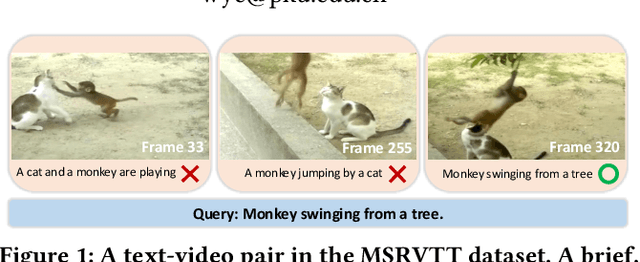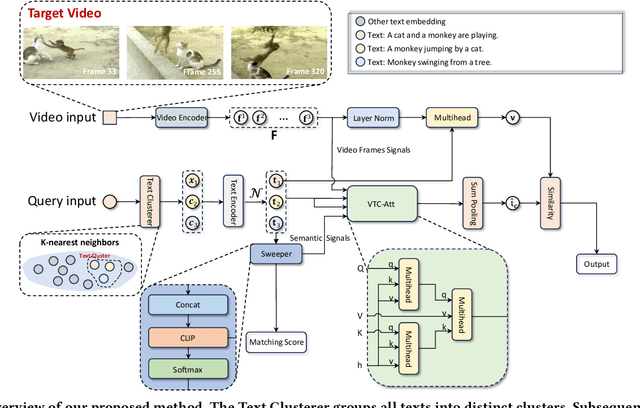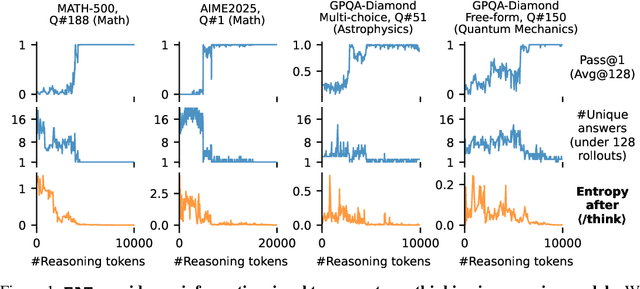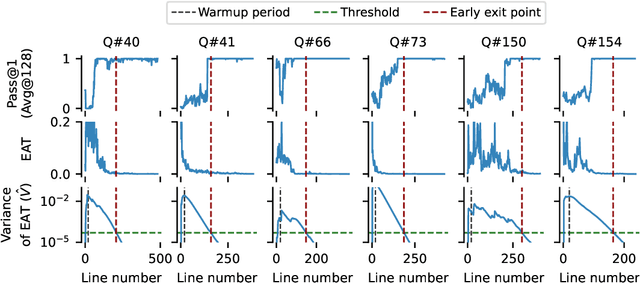Xi Wang
Queries Are Not Alone: Clustering Text Embeddings for Video Search
Oct 09, 2025



Abstract:The rapid proliferation of video content across various platforms has highlighted the urgent need for advanced video retrieval systems. Traditional methods, which primarily depend on directly matching textual queries with video metadata, often fail to bridge the semantic gap between text descriptions and the multifaceted nature of video content. This paper introduces a novel framework, the Video-Text Cluster (VTC), which enhances video retrieval by clustering text queries to capture a broader semantic scope. We propose a unique clustering mechanism that groups related queries, enabling our system to consider multiple interpretations and nuances of each query. This clustering is further refined by our innovative Sweeper module, which identifies and mitigates noise within these clusters. Additionally, we introduce the Video-Text Cluster-Attention (VTC-Att) mechanism, which dynamically adjusts focus within the clusters based on the video content, ensuring that the retrieval process emphasizes the most relevant textual features. Further experiments have demonstrated that our proposed model surpasses existing state-of-the-art models on five public datasets.
Pulp Motion: Framing-aware multimodal camera and human motion generation
Oct 06, 2025Abstract:Treating human motion and camera trajectory generation separately overlooks a core principle of cinematography: the tight interplay between actor performance and camera work in the screen space. In this paper, we are the first to cast this task as a text-conditioned joint generation, aiming to maintain consistent on-screen framing while producing two heterogeneous, yet intrinsically linked, modalities: human motion and camera trajectories. We propose a simple, model-agnostic framework that enforces multimodal coherence via an auxiliary modality: the on-screen framing induced by projecting human joints onto the camera. This on-screen framing provides a natural and effective bridge between modalities, promoting consistency and leading to more precise joint distribution. We first design a joint autoencoder that learns a shared latent space, together with a lightweight linear transform from the human and camera latents to a framing latent. We then introduce auxiliary sampling, which exploits this linear transform to steer generation toward a coherent framing modality. To support this task, we also introduce the PulpMotion dataset, a human-motion and camera-trajectory dataset with rich captions, and high-quality human motions. Extensive experiments across DiT- and MAR-based architectures show the generality and effectiveness of our method in generating on-frame coherent human-camera motions, while also achieving gains on textual alignment for both modalities. Our qualitative results yield more cinematographically meaningful framings setting the new state of the art for this task. Code, models and data are available in our \href{https://www.lix.polytechnique.fr/vista/projects/2025_pulpmotion_courant/}{project page}.
Entropy After $\langle \texttt{/Think} \rangle$ for reasoning model early exiting
Sep 30, 2025



Abstract:Large reasoning models show improved performance with longer chains of thought. However, recent work has highlighted (qualitatively) their tendency to overthink, continuing to revise answers even after reaching the correct solution. We quantitatively confirm this inefficiency by tracking Pass@1 for answers averaged over a large number of rollouts and find that the model often begins to always produce the correct answer early in the reasoning, making extra reasoning a waste of tokens. To detect and prevent overthinking, we propose a simple and inexpensive novel signal -- Entropy After </Think> (EAT) -- for monitoring and deciding whether to exit reasoning early. By appending a stop thinking token (</think>) and monitoring the entropy of the following token as the model reasons, we obtain a trajectory that decreases and stabilizes when Pass@1 plateaus; thresholding its variance under an exponential moving average yields a practical stopping rule. Importantly, our approach enables adaptively allocating compute based on the EAT trajectory, allowing us to spend compute in a more efficient way compared with fixing the token budget for all questions. Empirically, on MATH500 and AIME2025, EAT reduces token usage by 13 - 21% without harming accuracy, and it remains effective in black box settings where logits from the reasoning model are not accessible, and EAT is computed with proxy models.
GBV-SQL: Guided Generation and SQL2Text Back-Translation Validation for Multi-Agent Text2SQL
Sep 16, 2025Abstract:While Large Language Models have significantly advanced Text2SQL generation, a critical semantic gap persists where syntactically valid queries often misinterpret user intent. To mitigate this challenge, we propose GBV-SQL, a novel multi-agent framework that introduces Guided Generation with SQL2Text Back-translation Validation. This mechanism uses a specialized agent to translate the generated SQL back into natural language, which verifies its logical alignment with the original question. Critically, our investigation reveals that current evaluation is undermined by a systemic issue: the poor quality of the benchmarks themselves. We introduce a formal typology for "Gold Errors", which are pervasive flaws in the ground-truth data, and demonstrate how they obscure true model performance. On the challenging BIRD benchmark, GBV-SQL achieves 63.23% execution accuracy, a 5.8% absolute improvement. After removing flawed examples, GBV-SQL achieves 96.5% (dev) and 97.6% (test) execution accuracy on the Spider benchmark. Our work offers both a robust framework for semantic validation and a critical perspective on benchmark integrity, highlighting the need for more rigorous dataset curation.
A Multimodal Foundation Model to Enhance Generalizability and Data Efficiency for Pan-cancer Prognosis Prediction
Sep 16, 2025Abstract:Multimodal data provides heterogeneous information for a holistic understanding of the tumor microenvironment. However, existing AI models often struggle to harness the rich information within multimodal data and extract poorly generalizable representations. Here we present MICE (Multimodal data Integration via Collaborative Experts), a multimodal foundation model that effectively integrates pathology images, clinical reports, and genomics data for precise pan-cancer prognosis prediction. Instead of conventional multi-expert modules, MICE employs multiple functionally diverse experts to comprehensively capture both cross-cancer and cancer-specific insights. Leveraging data from 11,799 patients across 30 cancer types, we enhanced MICE's generalizability by coupling contrastive and supervised learning. MICE outperformed both unimodal and state-of-the-art multi-expert-based multimodal models, demonstrating substantial improvements in C-index ranging from 3.8% to 11.2% on internal cohorts and 5.8% to 8.8% on independent cohorts, respectively. Moreover, it exhibited remarkable data efficiency across diverse clinical scenarios. With its enhanced generalizability and data efficiency, MICE establishes an effective and scalable foundation for pan-cancer prognosis prediction, holding strong potential to personalize tailored therapies and improve treatment outcomes.
Generative Diffusion Contrastive Network for Multi-View Clustering
Sep 11, 2025Abstract:In recent years, Multi-View Clustering (MVC) has been significantly advanced under the influence of deep learning. By integrating heterogeneous data from multiple views, MVC enhances clustering analysis, making multi-view fusion critical to clustering performance. However, there is a problem of low-quality data in multi-view fusion. This problem primarily arises from two reasons: 1) Certain views are contaminated by noisy data. 2) Some views suffer from missing data. This paper proposes a novel Stochastic Generative Diffusion Fusion (SGDF) method to address this problem. SGDF leverages a multiple generative mechanism for the multi-view feature of each sample. It is robust to low-quality data. Building on SGDF, we further present the Generative Diffusion Contrastive Network (GDCN). Extensive experiments show that GDCN achieves the state-of-the-art results in deep MVC tasks. The source code is publicly available at https://github.com/HackerHyper/GDCN.
Fine-Tuning Vision-Language Models for Visual Navigation Assistance
Sep 09, 2025Abstract:We address vision-language-driven indoor navigation to assist visually impaired individuals in reaching a target location using images and natural language guidance. Traditional navigation systems are ineffective indoors due to the lack of precise location data. Our approach integrates vision and language models to generate step-by-step navigational instructions, enhancing accessibility and independence. We fine-tune the BLIP-2 model with Low Rank Adaptation (LoRA) on a manually annotated indoor navigation dataset. We propose an evaluation metric that refines the BERT F1 score by emphasizing directional and sequential variables, providing a more comprehensive measure of navigational performance. After applying LoRA, the model significantly improved in generating directional instructions, overcoming limitations in the original BLIP-2 model.
Revolution or Hype? Seeking the Limits of Large Models in Hardware Design
Sep 05, 2025Abstract:Recent breakthroughs in Large Language Models (LLMs) and Large Circuit Models (LCMs) have sparked excitement across the electronic design automation (EDA) community, promising a revolution in circuit design and optimization. Yet, this excitement is met with significant skepticism: Are these AI models a genuine revolution in circuit design, or a temporary wave of inflated expectations? This paper serves as a foundational text for the corresponding ICCAD 2025 panel, bringing together perspectives from leading experts in academia and industry. It critically examines the practical capabilities, fundamental limitations, and future prospects of large AI models in hardware design. The paper synthesizes the core arguments surrounding reliability, scalability, and interpretability, framing the debate on whether these models can meaningfully outperform or complement traditional EDA methods. The result is an authoritative overview offering fresh insights into one of today's most contentious and impactful technology trends.
FakeParts: a New Family of AI-Generated DeepFakes
Aug 28, 2025Abstract:We introduce FakeParts, a new class of deepfakes characterized by subtle, localized manipulations to specific spatial regions or temporal segments of otherwise authentic videos. Unlike fully synthetic content, these partial manipulations, ranging from altered facial expressions to object substitutions and background modifications, blend seamlessly with real elements, making them particularly deceptive and difficult to detect. To address the critical gap in detection capabilities, we present FakePartsBench, the first large-scale benchmark dataset specifically designed to capture the full spectrum of partial deepfakes. Comprising over 25K videos with pixel-level and frame-level manipulation annotations, our dataset enables comprehensive evaluation of detection methods. Our user studies demonstrate that FakeParts reduces human detection accuracy by over 30% compared to traditional deepfakes, with similar performance degradation observed in state-of-the-art detection models. This work identifies an urgent vulnerability in current deepfake detection approaches and provides the necessary resources to develop more robust methods for partial video manipulations.
Progressive Depth Up-scaling via Optimal Transport
Aug 11, 2025Abstract:Scaling Large Language Models (LLMs) yields performance gains but incurs substantial training costs. Depth up-scaling offers training efficiency by adding new layers to pre-trained models. However, most existing methods copy or average weights from base layers, neglecting neuron permutation differences. This limitation can potentially cause misalignment that harms performance. Inspired by applying Optimal Transport (OT) for neuron alignment, we propose Optimal Transport Depth Up-Scaling (OpT-DeUS). OpT-DeUS aligns and fuses Transformer blocks in adjacent base layers via OT for new layer creation, to mitigate neuron permutation mismatch between layers. OpT-DeUS achieves better overall performance and offers improved training efficiency than existing methods for continual pre-training and supervised fine-tuning across different model sizes. To further evaluate the impact of interpolation positions, our extensive analysis shows that inserting new layers closer to the top results in higher training efficiency due to shorter back-propagation time while obtaining additional performance gains.
 Add to Chrome
Add to Chrome Add to Firefox
Add to Firefox Add to Edge
Add to Edge